Text
A Return From The Grave
I am admittedly new to this whole... post regularly thing. So I dropped off for a while. But a LOT has happened.
I released my first game in a game jam!
Waker0 and myself put this together over about a week for GB Jam 11 back in October. It was a lot of fun and sure, it's on the shorter side, but I got to play with a lot of aspects I hadn't before like game art and animation.
I also completed some coursework at the local community college in Game Design. Learned a bit from that, but I've also been learning a ton from other folks in the industry who are kind enough to help out the new folks despite the horrible layoffs we've been seeing.
On the job front, I still don't have one of those. It's a tough market and there's a lot of very talented people out there who have been doing this longer than I have. I had the opportunity to meet with quite a few of the at San Francisco's Game Developer Conference a few weeks ago.
I do have an exciting announcement coming up here in a week or two, so stay posted for that, but in the meantime I'm glad to be back and I'll see y'all real soon.
10 notes
·
View notes
Text
The Importance of Interest
It's been a little while since my last "on making a game" installment, and I'm in a mood to talk about interesting things... so why not Points of Interest in light of my current pet project Everwyld?
I'm in the midst of developing a world that has been truly abandoned, where players have few intelligent entities to interact with - no people, gods, robots, or holograms. This is, in a sense, the survival game of survival games: players will only have the tools they can create and knowledge they can accumulate for themselves. And if I'm being honest, I'm taking a not-insignificant amount of inspiration from Subnautica, since they made this vision an excellent reality.
(Going forward, blanket spoiler warning for locations in Subnautica. If you haven't played it and don't suffer from thalassophobia, you certainly should.)
The first challenge, and one that's doubly difficult in the analog format I'll be running this game while I develop the setting, if building player investment through their interactions with the world. Different genres and titles accomplish this in different ways.
The classic survival-crafting game Minecraft has kept players invested over its service life through the addition of new features, biomes, mechanics, the introduction of multiplayer, and a thriving, supported modding community.
The multiplayer survival-crafting FPS Rust created interest for players in the world through the inclusion of other players, and the option to cooperate or resort to every-man-for-themself anarchy.
Subnautica accomplishes this investment of players in the world through the inclusion of alien environments. This doesn't just mean the alien lifeforms, but the concept of the deep sea and what the various environments look like - which are often shockingly accurate excluding the giant man-eating fish - are alien to so many people who don't have the means or guts to dive through the deep ocean, and I count myself among them.
Something all of these games (and more) include to further create a player interest in the world and exploring it, though, are points of interest. None of them are unbridled wilderness. Minecraft's structures range from thriving villages, to abandoned mineshafts and shipwrecks, to the strongholds. Even the Nether and End dimensions have their own native structures. Subnautica has not only the various debris fields from the Aurora, but the Enforcement Platform, the submarine alien facilities, and the Degasi bases. In Rust, a variety of monuments dot the landscape with various traits, loot, and benefits.
Not only do these structures and points of interest enhance the world, but they change how the player will interact with it. A Subnautica player may build bases near major resource deposits or repurpose existing structures for their benefit. A Rust player may establish their base near an easy resource cache, like the farmable Underwater Rocks. In Minecraft players may use large structures as a base, or as a point of reference when navigating the functionally infinite world.
So what kind of points of interest will I be including in Everwyld? Well, as I said, the world was abandoned. It's a region largely reclaimed by nature, so much so that the artificial blemishes have all but faded. My players will start in a place truly devoid of signs of settlement, a beautiful and serene glade... (which I've taken the liberty of rendering in Unreal Engine 5 here)
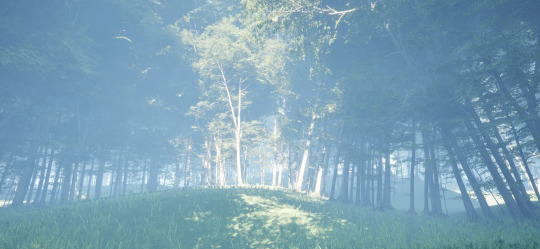
Nearby are most of what they will need to survive: a source of flowing water, a game run that cuts through the forest, but what encourages them to venture from this serene space will be their curiosity as to what happened to them, and how they can hope to get home. This world is full of natural dangers, but if they brave them and survive they may find the remnants of a village where the stones jutting from the ground make odd squared angles, or a monolith that a tree has grown to encompass.
Mayhap they'll uncover something better preserved underground, or through some advanced means, that will hold answers and tools for them to delve deeper into the mystery and find their way home.
Until next time!
#game development#level design#world design#Rust#subnautica#minecraft#unreal engine#survival#mystery#nature#Everwyld
4 notes
·
View notes
Text
Long Hiatus for a Big Project
So... I disappeared for a little while - but it was for good reason! I've spent the last couple of weeks on a variety of things:
First, I participated in GB Jam 11. This game jam is a competition in full game development, where entries have all of their assets, mechanics, and materials produced over the 10 days of the jam! GB Jam specifically is a competition where you develop games in the classic Game Boy style - 4 colors, limited audio channels, and a lot of pixelation. I worked with a wonderful audio designer and composer Waker0, whose itch page is here. We developed Fleet of One, which placed #208 out of 404 submissions. I'm happy with the finished product, especially as it was my first time working with the game engine, as well as my first time doing any sprite work and art, especially 8-bit.

I also, following some of the Unity drama, started familiarizing myself with Unreal Engine 5. It's a fascinating piece of software and I'll certainly be writing more on it in the coming days and weeks. Anyone interested in learning I'm happy to provide some resources - but I mean it when I say that making a game is so much less complex than it was 10 years ago. It's still a labor of love, and takes time, and you need to be passionate - but there's so many easy-to-use tools to get your feet wet. I've met so many people who abandoned it because programming was too hard for them, don't let that stop you. Work in Scratch, Godot, or Unreal Blueprint; the extra abstraction layer makes it so much easier to approach, and you'll learn from there.
Finally, my portfolio site is finally live here if you want easy access to some of my favorite projects as I continue the along my road.
Until next time!
1 note
·
View note
Text
Don't think I've mentioned this but I am also a columnist for Zelda Universe. I just published, in my opinion, an excellent analysis on the tutorial formula for Legend of Zelda games, and all of my colleagues are just as fantastic in their own fields: from music and art to trivia and world design.
If you want to see more of my work and theirs, especially if you're a longtime Zelda fan like me, go check it out!
3 notes
·
View notes
Text
I've been a bit of a lurker of @ganondoodle for a while but watching some of the process and ideas in the totk rewritten project has been fascinating to me and this may be one of my favorites so far.
I always felt a little underwhelmed when I made it to the bottom of the Deku Tree and it was just Gloom Hands.

rough concept for the unique boss within the deku-tree
(required for the quest to repair the mastersword; boss name is a placeholder)
(totk rewritten project)
#deku tree deserves a unique boss#gohma belonged to the forest first#zelda#art#totk#game design#we didn't need more gloom hands tbh
4K notes
·
View notes
Text
Dev Journal: Days 5-10
It's been a while and that's largely because the most recent steps taken have been largely processes that are repetitive, minor, and sometimes unseen.

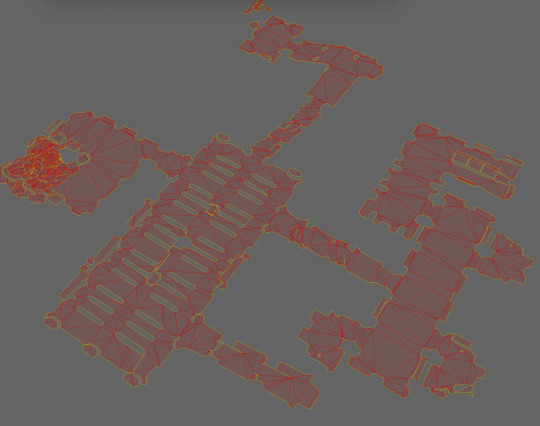
First things first, TRIANGLES. The navmesh for the interior cell is done (including exclusions around the bookcases and tables), which has solved all of my problems with AI pathing because, well, they aren't playing a game of 'The Floor is Lava' anymore.

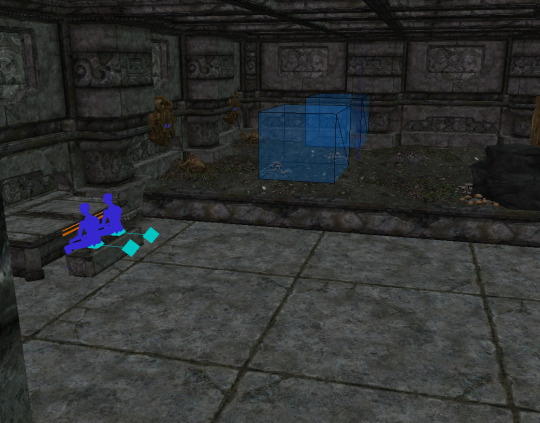
The other major change is some changes to population. We've added some Dwarven Spiders that still loyally tend to the grounds, as well as adding a true trove of information to the library, though most of it has long eroded to the ages. Within the library, the ambient magic of some tomes and scrolls have allowed them to endure the test of time, some of which you can see in the first capture by the orange DummyBook objects, which will generate leveled spell tomes when you first enter the Vault.
Hopefully, Bookwyrm's Vault will be seeing its beta 0.9 release on Nexus soon. There's a lot more I want to do with this dungeon, including some quest implementation and adding one or two additional obstacles in the overworld around the location, but for now it's near completion for the interior.
No new trivia for today, unfortunately, but writers may look forward to my next post, where I'm going to talk about constructing novel ecosystems for world design. Until we meet again!
#game development#bookcore#dwarves#level design#magic#modded skyrim#modding#skyrim#video games#library
3 notes
·
View notes
Text
Dev Journal: Day 4
After a short vacation that was more days of travel than days of fun, give or take a couple days of work, I'm back at my desk and continuing the Bookwyrm's Vault.
Today I've settled on the organization of the main scriptorium, started furnishing the librarians' cell and started populating the ruin a bit.

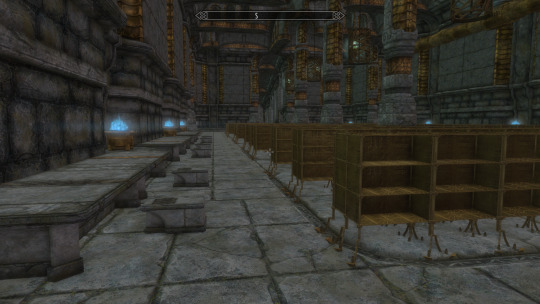
The scriptorium is lit not only by the great chandeliers hanging from this hall's rafters, but enchanted brasiers whose fires have burned longer than the tale of Ysgramor has sat in the ears of Nords. Featuring a number of bookcases, which have yet to be filled by miscellaneous books and parchment, this hall truly once would have put to shame the collection of the College of Winterhold.


The private studies hall now features a patrolling Dwarven Sphere, though I have yet to get the thing to move beyond the first link in its patrol route - still learning nav mesh gradually I suppose. There used to be two guardians of this hall, but I decided one ought to have been caught up in the cave-in.
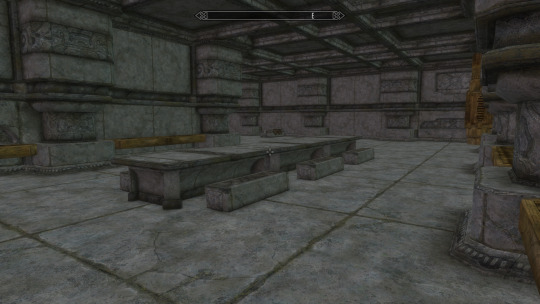
Finally, the librarians have their own space, with plenty of shelving and table room. They also have beds (not pictured) which have yet to be accompanied by nightstands.
I'll also note the beginnings of the pipe network for this Dwemer ruin, which was largely used to heat and maintain a consistent environment in the interest of preserving the books.
That's all for tonight, but hopefully Sunday I'll be back with some more not-so-friendlies, like the Dwemer Spider lab assistants, as well as some proper lootable clutter.
Unfortunately, no new trivia this time around, but to make up for it, enjoy my first attempt at sprite animation: just a little slime wiggling by:

#game development#bookcore#dwarves#level design#magic#modded skyrim#modding#skyrim#video games#library
2 notes
·
View notes
Text
When Players Commit to the Bit
My last post talked a little about player buy-in, and its impact. Again, as far as game design goes, my experience is limited to personal experience playing games and the experience I have as a Game Master for tabletop RPGs, but especially in those varieties of fiction, player buy-in matters. I'm going to address two particular games where this made all the difference.
To start with a group of players that has really knocked my socks off, I'll tell this first story from the players' perspective, as I was one in this rare occurrence. Any D&D5e veteran knows that the system was built for medieval power fantasy; the existence of the spell fireball is enough justification on its own, but should you need a few additional examples from a DM's perspective:
The 1st-level spell heroism completely negates the frightened condition, regardless of its source, and is available to any divine caster at 1st level. At higher levels this is the solution to fear effects from creatures like dragons, who often have DCs that creatures lacking the appropriate save proficiency could never succeed on.
The game itself has a terrible exploration and social interaction system, just look at the memes. There's a reason the homebrew community is so strong when it comes to additional or revamped mechanics.
The game also has a terrible inability to run Battle of Helm's Deep-esque situations because it is precariously balanced in the system of action economy - assuming that players will always be up against enemy groups of similar size and strength to their own.
This problem is further exhausted when specific genres, like horror or survival, come up. That's because, again, the game is balanced in the player's favor by default. Nothing should be scary until it is a definite loss for the party. Not to mention numerous background features and low-level spells immediately negate the concern of finding food, water, or medicine - as well as treating diseases and poisons.
So, dear reader, you may find it interesting when I say that my favorite experience as a player was in a modified version of the Curse of Strahd module. Curse of Strahd is a survival and gothic horror module that was heavily influenced by Bram Stoker's Dracula, for those unfamiliar. As I've already stated, the system of D&D5e is not well-suited to these types of challenges without using tactics that severely cripple players and their abilities. However, in a combination of excellence on the Game Master's part and the buy-in of all of the players, this game has been one hell of an experience.
Not only did every player come to the table with a self-motivated and layered, perhaps even somewhat corrupted, motivation - but those motives and characters have been well-played by the players in response to the appropriate types and levels of pressure applied by the DM, both on the characters in fiction but also on the players at the table. Every session ends in a cliffhanger, which only helps preserve the mindset from week to week of being in the game.
We also are tolerant, as a group, to making less-than-ideal decisions. Our characters may flee, even if nothing mechanically compels them to do so. They may make hasty decisions, or even evil things, and the characters themselves may create and relieve tensions throughout the group. Curse of Strahd has become gothic horror done right in D&D with this group because we as players let ourselves be afraid, be invested in our character's survival, and follow a narrative that is always changing and reacting.
Not quite in contrast, but certainly from another angle, I have had my best experiences and pride in my work as a DM when my players truly invest themselves in the world and connect with it. In my most recent, and possibly last ever, 5e campaign I had built a world that was embroiled in a continental war, specifically over the use of magic. At the outset of the game, I informed my players that this conflict had gone on for quite a long time, with many tenuous peace treaties over the decades, so the nation of origin for these characters would vastly influence how they perceived the world, due to various levels of propaganda, so they would have to choose together what nation they were loyal to, though that loyalty could change over the course of the campaign. The final composition of the party was a cloistered cleric, who would have had little opinion were it not for a raid on their church; a soldier, who deserted after being hunted for breaking laws regarding the use of magic in an attempt to save their ill father; a commoner, who knew little of the outside world but had grown up in a nation where the use of magic was free and unrestricted; and an ex-assassin, who had served in the interests of that same nation of free use of magic until they fell in love with a political target of a rival nation.
Now, they did not find their loyalties to change over the course of the campaign, but the beauty in this story was that none of the characters died (except for the time the wizard decided against the clear indication that this was a death wish to proceed). The players themselves asked for death to be uncommon and meaningful, and I was happy to comply. What this required me to do as a Game Master, however, was to find other means of motivating the party to action, as few of them had a moral or personal obligation to take any side in this war. For this, I used two strategies:
Threats to Security. I used the proximity of their home to contested territories to motivate their actions to protect their sense of security. Not only were some missions mandatory service, assigned by the local legislature, but there were also night raids from across the border that directly threatened the characters, and those they wished to protect. Which brings us to
Exploiting Relationships. I also used the NPCs the party cared about, most famously the two children of their patron, to drive direction and urgency in the narrative. In retrospect I used kids in general a lot to pull at heartstrings, but so does UNICEF and a number of other relief organizations.
To the players' credit, they went all-in and there were not only excellent inter-party relationships, but various party members had differing opinions on the societal needs in the future that were derived from their experiences and the NPCs they were most involved with by the end of the campaign.
I can't say I have a great way to close this one other than saying that sure, this is my experience and ymmv, but player buy-in can make a massive difference in gameplay and the options available to a designer to make a truly immersive and memorable experience.
4 notes
·
View notes
Text
Telling a Story Through Gaming: Making an Immersive Experience
I know it’s been a couple days since I updated on Bookwyrm’s Vault, and if I’m being entirely honest it’s because my other job wiped me out and then I spent all day today traveling, so there’s been no movement on that front over the last three days. However, I did say that I would hopefully be sharing some more general-use advice and other projects along the way, so for today I will be tapping into the reasons and people that drove my ambition to do this - hopefully to the benefit of others with similar interests.
I believe I’ve said before that I’ve spent the last 5 years of my life as a perma-DM - in fact it’s how I made friends in college and I was a board member of my college’s tabletop games club. With 5 years of running games, I tended to have no fewer than 2 games I was running at any given time, with each campaign being hosted weekly for anywhere between 4 months and 2 years. Some games went well, others fell apart, and some were just meant to be short, it was as much a creative outlet as it was a social event for me. I suppose that brings me to my first and largest piece of advice for anyone interested in making more than just a game, but an experience: Forget yourself.
Now this doesn’t mean disregard yourself, after all it is your creativity, passion, and drive that will ultimately make your game - it’s your product and you should be proud of it. But when you make a truly immersive experience, like a D&D campaign or a sandbox game, you need to realize that your players, who are given nearly unlimited ability to interact with your world, will inadvertently act in a way you don’t consider, intend, or sympathize with. Similarly, there may be things that they simply don’t care or think about as much as you do. To this second point, I encourage anyone who loves internet lore videos to interact with Polygon’s Skyrim Book Report (link: https://www.youtube.com/watch?v=RVdTZhmsGsU) hosted by the marvelous Brian David Gilbert.
What I mean to say in this is that you are creating a product that you are passionate about. So many people will make their first game as something they would want to play. This is true of other creative fields as well: animation, music, fiction... and the truth that you will have to accept is that what you wish to experience may be too niche, or complex, or tailored to your personal experience to gain traction or interest. In the case of me drawing from experience as a Game Master, I will call this player buy-in.
Buy-in makes or breaks an experience for your consumer. If your magic system is endlessly complex, a player looking for a simple power fantasy to escape the stress of a desk job may quickly discard it to collect dust. If your zombie game turns out to be a settlement managing game with an external and seldom-addressed threat of zombies, you’ll likely lose the interest of the Walking Dead crowd who are interested in the nomadic wasteland survival aspect of the genre. What’s worse is falsely advertising, or poorly portraying, your product to people potentially interested can cause lasting harm in the trust they have in your later products.
Not only this, but buy-in will impact the feedback you get from your consumers. The makers of Until Dawn no doubt put a lot of effort and energy into the photorealistic environments and occult horror of their wendigo models, but a comment praising the “good graphics” will not mean nearly as much as the feedback from a player who plays horror games to be scared, who “spent the last four hours on the edge of my seat, looking over my shoulder in my dark game room”. It’s the feedback that appreciates the spirit of your product that not only tells you what you did right, instead of just well, but also gives you the energy, motivation, and validation to keep doing it.
Tomorrow I will talk about my favorite experiences from TTRPGs as an invested player versus as a Game Master with invested players, and the world of difference it makes. If people like these little advice posts, I’ll be happy to continue them. It makes for a good fallback when I hit roadblock or am taking breaks for work-heavy periods. Hopefully on Tuesday I will have some progress to report on the Bookwyrm’s Vault, one way or another.
10 notes
·
View notes
Text
Dev Journal: Day 3
Alright, I think the layout has been finalized! I went through and addressed the handful of notes I made by location in yesterday’s post. Today I spent a few hours furnishing this ruin, more specifically the quite cells, lab, and scriptorium. I also have a new bit of trivia for you at the end of today’s post, courtesy of the weird way object hierarchies work in programming.
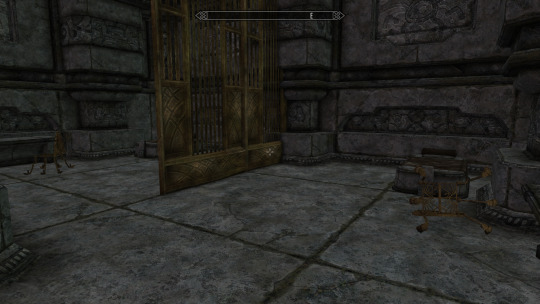
The bedcells still felt way too spacious, so I decided to make them doubles with a partition. After all, if they don’t want you making extended stays, why would they offer you a single? Colleges do the same thing to encourage students to move off campus, right?
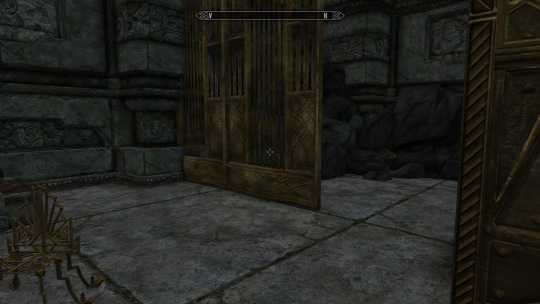
And of course each cell can’t be the same, so one of them is collapsed. Let’s hope no one was in that chair when it happened.
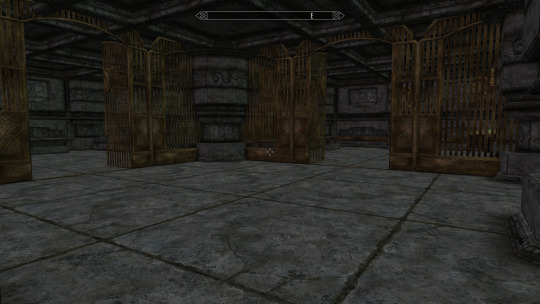
The lab has seen some major changes, after I came to realize that alchemy and enchanting tabletop units couldn’t be placed on dwemer podiums, thanks to the significant lip they had. When you enter, the alchemy and enchanting labs are partitioned off as well.

The enchanting lab has easy-access shelving where soul gems and other enchanting aids could be set in-process, to avoid any terrible mishap by cluttering your enchanting table. There are also a handful of desks here for theory work or storing larger items, like arms and armor awaiting enchantment.

The alchemy lab is, by contrast, a little more sparse. I will be adding a few dwemer urns to this room in the cluttering process, which may have once held large quantities of reagents or byproducts. It does still have shelves for storing ingredients while working - those void salts are expensive, after all.

What I did do to add to the alchemy lab, however, was construct this small subterranean mushroom grove. I’m in the process of adding plants to it, but they are proving to be difficult to locate in the resource directory.
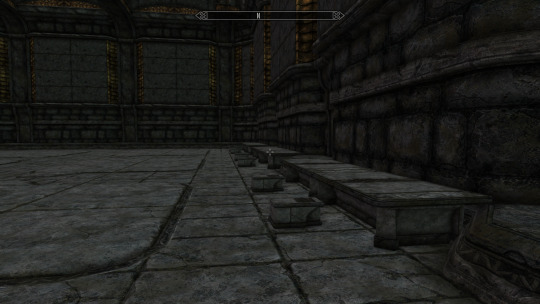
Finally, the scriptorium gained some desks (and lost the carpet runner, for the time being). When I get around to cluttering this room, these desks will be covered with ruined books, inkpots, quills, and the occasional scroll from work long past. This room still is awaiting bookshelves, but I’m not decided on a layout quite yet.

And of course what would this be without a full-progress pic from the Creation Kit window?
Before I get to today’s trivia, it’s worth saying that you won’t be hearing from me tomorrow, as I have a seven hour shift at my actual part-time job, so I won’t be working on this project again until Friday. Hopefully the next update has some considerable change to the Scriptorium and some furnishings for the people who lived here, right? Now, what you may have been waiting for.
Did you know? In the Skyrim file directory, the assets for bird nests and coin purses are classified as flora objects because they inherit the harvestable property of the other flora objects, like mushroom clusters. This is because the overworld sprite does not match the harvested material (eggs in the case of bird nests and coins in the case of coin purses). It also means that it is likely that these objects use the same respawn timer as the mushrooms in the world map. Riften rats, watch how fast the mushrooms grow, as they may give you a sign of riches to come.
#skyrim#modded skyrim#modding#level design#video games#game development#dwarves#magic#bookcore#alchemy#enchanting#library#nightingales#shadowmarks#omg wait the mushroom would be a good shadowmark for someone who makes money quickly
2 notes
·
View notes
Text
Dev Journal: Day 2
I’d be lying if I said I wasn’t surprised to see some attention already on my post yesterday, and it makes me happy to see some people who are already interested. So I’ll start by saying thanks for the support!
Before I go over the developments of today, I guess it’s worth saying exactly how much time is going into this daily. My routine is getting to my desk at 9am, teaching myself Unity and C# through to about 1:30pm, taking about 40 minutes for lunch, and then Creation Kit from the end of my lunch to about 5pm, maybe 6pm on days that I don’t have anything going on in the evenings. Once I’m done with the Creation kit work for the day, I write, so that I can take screencaps without needing to restart my work environment from earlier that day.
So with about 3 hours of work today, what got done? The full structure is built! There’s no glaring holes into the void, though I did notice that a couple of my tiles are placed a few pixels into another, causing some graphical twitching, but that’s okay, and it’ll get fixed tomorrow while I go about furnishing. I also took the time to place a couple of detail items around, but honestly my brain is fried at this point so I’ll probably go back and do it again later. The only negative result from today is that the two-tier library isn’t going to work with the existing textures, but that’s alright.
So what am I going to show you today? Well... everything. All of the rooms in their minimal state, and maybe I’ll write a brief blurb on the context of each of them and changes I noted to make for myself as I was walking around in demo mode. If you ride it out to the end, there’s a little bit of Skyrim trivia for you too!

The scriptorium will be the main vestibule of this construction. In its finished product, the center of the room will be filled with bookshelves in a classic record-stack format, while desks will line the walls for scribes and researchers alike to study, transcribe, and dispute the works contained in the Vault’s extensive library. While this place has long fallen into disrepair, more magical works like spell tomes, scrolls, or books of particularly important and interesting lore may still litter the desks and shelves of this room. I need to reorient a handful of tiles in this room to remove a couple overlaps, but otherwise it just needs to be detailed.
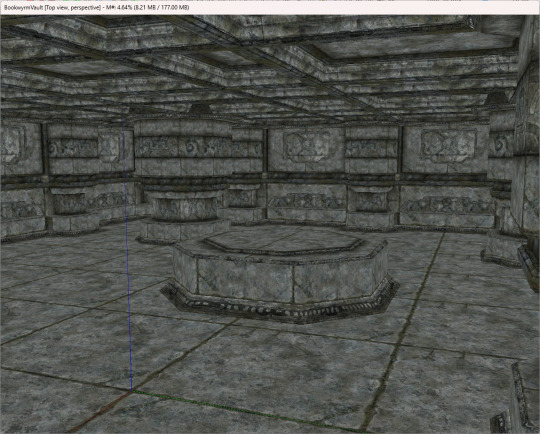
The laboratory may be a small space, but it was designed that way so the use of the space for long-term experiments was discouraged. The vault was not built to accommodate travelers for weeks on end, but to house them for a few days while they performed their research to take home to their own labs. Of course, some of the librarians held private experiments and studies that were more involved and time-consuming.

Opposite the lab are a handful of quiet cells, used by guests for sleeping accommodations or personal study. The northwestern cell is a communal bedchamber for the librarians, as well as a small section of the room used for the repair of degrading or damaged tomes. During my walkthrough I felt as though the guest cells, and perhaps even the resident cell, were a bit too large, so I may use different closing tiles for the far walls tomorrow before I start furnishing, or make the decision after I’ve furnished one. Also all of these cells still need doors.

This shot is taken from the opposite side of the Special Collections door, where few individuals were permitted. The entrance is off down the left fork of the hall, and to our back will be a reading area for these reserved or restricted titles. Down the corridor lies one more chamber where the head scribe was conducting some interesting research into... well, now, I can’t give everything away, can I?

I suppose that covers everything for today! Tomorrow likely won’t be as long-winded, nor have so many pictures, but I hope you’ll continue to enjoy it regardless. Now, I made a promise of trivia. It’s something I learned today while testing.
Did you know that the standard character in Skyrim, if you were to travel to another map location via the coc command from the main menu instead of loading/beginning a save, is a Nord with iron armor, an iron shield, the iron one-handed weapons, a longbow, and iron arrows - much like the promotional character from the trailers all those years ago? It also means those pesky Imperials took the armor off your back when you got caught up in that ambush. Just another reason to side with the Stormcloaks, I guess.
#skyrim#modding#level design#game development#video games#modded skyrim#dwarves#bookcore#library#magic#die imperial scum#for ulfric#for skyrim#make talos worship legal again
4 notes
·
View notes
Text
Dev Journal: Day 1
I’ve tried a few times at putting myself out there with my system, boss, level, and world design content. Every time I did it for feedback, or validation, because I was looking for a reason to go out and do it full-time. Well, I’m now fresh out of college, a year down the drain trying to find any job that matches my qualifications, and have nothing better to do than to take the hobby I’ve poured countless hours into and run with it. So now this blog is finally just going out there for myself; clean slate.
For anyone who finds themselves becoming an interested and long-time fan of my work, I’ll document where I’m starting from here. Like I said, I’m fresh out of college. Twenty-two years old with a degree in Statistical Analysis, and a sizable amount of coursework in Operations, Actuarial Math, and Physics to boot. All that aside, I’ve been a huge game nerd for 15 years, been writing worlds and systems for a decade, and have been a perma-DM of both Dungeons and Dragons as well as, now, Pathfinder for a sum total of 5 years and counting. Needless to say, I’m a nerd who wasn’t encouraged to write - so I did all the hard homework first to make time for it.
This blog is gonna start out kinda boring, it’s really just me documenting what I’m doing. In part so I can look back at it, in part so I have it all somewhere that can be seen, and finally just so I can put myself out there. Being nerdy doesn’t really score you a huge network until well after school. Eventually I’m hoping to put some of my old D&D content and notes as a DM and worldbuilder out there. Maybe someone will learn something, maybe not.
Regardless, today was Day One. My first steps to really becoming a game designer. I’ve always had a knack for level and world design. I like making things that feel meaningful and have something to add. I’ve also been infatuated with The Elder Scrolls V: Skyrim since I was in middle school. So me, who has no credentials in softdev or compsci, well how am I going to make myself stand out to game studios? I’m starting with the Skyrim Creation Kit, and hopefully I can make something good enough to play with the big boys in some of the large community projects.
Today is Day One, Project One: The Bookwyrm’s Vault.
When I think of Skyrim, I think of three things. Vikings, dragons, and the Jedi Greybeards. But when I think of my ideal fantasy, I think of the wizarding type of sorcery, I think of arcane dragons - long-lived individuals who have honed magic over generations. And who’s to say that the dragons of Skyrim can’t be this way, Parthurnax certainly is.
So I devised the idea of the Bookwyrm’s Vault. I’m still undecided whether it is a Dwemer ruin built around the den of a long-departed dragon, or a ruin which a dragon took interest in. Regardless of which, the goal of this dungeon, unlike many of those in Skyrim, is not to add a crawl through enemies to feed the martial prowess of so many of the races of Tamriel. It’s to instead create something once beautiful and tranquil.
Initially I thought to conform to the Dwemer dungeon stereotypes of long hallways with many guardian automatons and littered steamworks and metal scraps. I’ve decided instead to be less industrious and more mystic and monastic with this ruin, to design a great library of magic and lore, one that rivals the College of Winterhold. Perhaps some Dwarven Spiders, remnants of a bookkeeping system as degraded as the parchment, remain to provide a small inconvenience to the Dragonborn. Even maybe a few runes of fire and lightning protecting more secretive experiments, or lingering from the attempts to keep something else in. This is my level, my addition, and I want it to reflect my interests in fantasy.

Now, today was my first day working with the Creation Kit. Panning with the MMB is a new experience, and wow could it use an efficiency update, but it is a decade-plus old piece of software, so I guess it gets a pass. For my first time working with the software, and having no clue what assets Skyrim actually uses, I decided to go pretty simple.
We start, as all subterranean dwellings must, with a passageway down and in to the earth, allowing all the room needed to carve out the great recording hall that is front and center. This room will, once populated, hold a dozen or more desks in varying states of repair and organization, and will have been where historically research of older tomes and transcription was done.
To the east of the recording hall, I’ve made a larger laboratory for more practical experimentation, which will feature a handful of crafting stations, like an alchemy and enchanting table, as well as maybe a staff enchanter if I feel inclined to make this mod require the Dragonborn mod.
To the west of the recording hall I plan to have a short hallway that connects a number of bedchambers, or private cells. A place to rest or study quietly.
Finally, to the south a passage leads further down. The door at the end of this passage will be locked, and I feel the key would be best kept in a well-warded chest in one of the private cells, as it leads to the special collections room.
Based on what I’ve seen of the assets library so far, I’m worried about making the special collections room because I had been hoping to make it a two-tiered library, but that may not be possible with the assets that exist and I certainly don’t have the experience to produce new ones. I may be able to use some of the components normally reserved for exteriors to get by, though. Only time will tell.
#skyrim#modded skyrim#modding#video games#game development#level design#magic#bookcore#dragons#dwarves#learning through play
10 notes
·
View notes